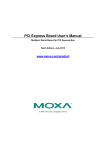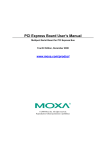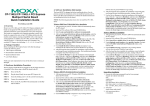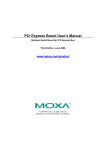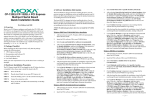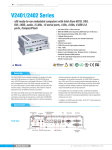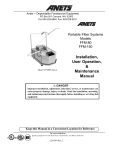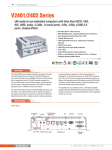Download PCI Express Board User`s Manual
Transcript
PCI Express Board User’s Manual Multiport Serial Board for PCI Express Bus Fifth Edition, October 2009 www.moxa.com/product © 2009 Moxa Inc. All rights reserved. Reproduction without permission is prohibited. PCI Express Board User’s Manual The software described in this manual is furnished under a license agreement and may be used only in accordance with the terms of that agreement. Copyright Notice Copyright © 2009 Moxa Inc. All rights reserved. Reproduction without permission is prohibited. Trademarks MOXA is a registered trademark of Moxa Inc. All other trademarks or registered marks in this manual belong to their respective manufacturers. Disclaimer Information in this document is subject to change without notice and does not represent a commitment on the part of Moxa. Moxa provides this document “as is,” without warranty of any kind, either expressed or implied, including, but not limited to, its particular purpose. Moxa reserves the right to make improvements and/or changes to this manual, or to the products and/or the programs described in this manual, at any time. Information provided in this manual is intended to be accurate and reliable. However, Moxa assumes no responsibility for its use, or for any infringements on the rights of third parties that may result from its use. This product might include unintentional technical or typographical errors. Changes are periodically made to the information herein to correct such errors, and these changes are incorporated into new editions of the publication. Technical Support Contact Information www.moxa.com/support Moxa Americas: Toll-free: 1-888-669-2872 Tel: +1-714-528-6777 Fax: +1-714-528-6778 Moxa China (Shanghai office): Toll-free: 800-820-5036 Tel: +86-21-5258-9955 Fax: +86-10-6872-3958 Moxa Europe: Tel: +49-89-3 70 03 99-0 Fax: +49-89-3 70 03 99-99 Moxa Asia-Pacific: Tel: +886-2-8919-1230 Fax: +886-2-8919-1231 Table of Contents Chapter 1 Introduction..............................................................................................1-1 Overview ............................................................................................................................ 1-2 Applications ....................................................................................................................... 1-3 Features .............................................................................................................................. 1-3 Package Checklist .............................................................................................................. 1-4 Installation Flowchart......................................................................................................... 1-4 Chapter 2 Hardware Installation ..............................................................................2-1 CP-118EL-A Dimensions................................................................................................... 2-2 CP-168EL-A Dimensions................................................................................................... 2-2 CP-104EL-A Dimensions................................................................................................... 2-3 CP-102E Dimensions ......................................................................................................... 2-3 CP-102EL Dimensions....................................................................................................... 2-4 CP-132EL Dimensions....................................................................................................... 2-4 CP-132EL-I Dimensions .................................................................................................... 2-5 CP-114EL Dimensions ....................................................................................................... 2-5 CP-114EL-I Dimensions .................................................................................................... 2-6 Plugging the Board into an Expansion Slot........................................................................ 2-6 Chapter 3 Software Installation ...............................................................................3-1 Windows Drivers................................................................................................................ 3-2 Windows 7 (32-bit/64-bit) ...................................................................................... 3-3 Windows 2008/Vista (32-bit/64-bit) ..................................................................... 3-16 Windows 2003/XP (32-bit/64-bit) ........................................................................ 3-28 Windows 2000 ...................................................................................................... 3-42 Non-Windows Drivers...................................................................................................... 3-57 DOS ...................................................................................................................... 3-57 Linux (32-bit/64-bit) ............................................................................................. 3-60 SCO....................................................................................................................... 3-62 Chapter 4 Serial Programming Tools......................................................................4-1 Moxa PComm .................................................................................................................... 4-2 Installing PComm ................................................................................................... 4-2 PComm Programming Library................................................................................ 4-2 Utilities............................................................................................................................... 4-2 Diagnostics (for Moxa boards only) ....................................................................... 4-2 Monitor (for Moxa boards under Windows 2000/XP/2003) ................................... 4-3 Terminal Emulator .................................................................................................. 4-4 RS-485 Programming......................................................................................................... 4-4 ADDC™ ................................................................................................................. 4-4 Chapter 5 Pin Assignments .....................................................................................5-1 CP-118EL-A....................................................................................................................... 5-2 Board Side Pin Assignments—Female SCSI VHDCI68 ........................................ 5-3 Device Side Pin Assignments ................................................................................. 5-4 CP-168EL-A ...................................................................................................................... 5-6 Board Side Pin Assignments—Female SCSI VHDCI68 ........................................ 5-6 Device Side Pin Assignments ................................................................................. 5-7 CP-104EL-A ...................................................................................................................... 5-9 Board Side Pin Assignments—Female DB44......................................................... 5-9 Device Side Pin Assignments ............................................................................... 5-10 CP-102E ............................................................................................................................5-11 Board Side Pin Assignments—Male DB9 ............................................................ 5-11 CP-102EL..........................................................................................................................5-11 Board Side Pin Assignments—Female DB25....................................................... 5-11 Device Side Pin Assignments ............................................................................... 5-12 CP-132EL/CP-132EL-I.................................................................................................... 5-12 Board Side Pin Assignments—Female DB25....................................................... 5-12 Device Side Pin Assignments ............................................................................... 5-13 CP-114EL/CP-114EL-I .................................................................................................... 5-13 Board Side Pin Assignments—Female DB44....................................................... 5-13 Device Side Pin Assignments ............................................................................... 5-15 Chapter 6 Troubleshooting ......................................................................................6-1 General Troubleshooting .................................................................................................... 6-1 Appendix A Technical Reference............................................................................... A-1 Product Specifications....................................................................................................... A-1 CP-118EL-A Specifications................................................................................... A-1 CP-168EL-A Specifications................................................................................... A-2 CP-104EL-A Specifications................................................................................... A-3 CP-102E Specifications ......................................................................................... A-4 CP-102EL Specifications....................................................................................... A-5 CP-132EL Series Specifications ............................................................................ A-6 CP-114EL Series Specifications ............................................................................ A-7 1 Chapter 1 Introduction Moxa’s PCI Express serial boards meet the new slot standard for expansion boards, and work with any PCI Express slots. The boards have multiple RS-232/422/485 serial ports for connecting data acquisition equipment and other serial devices to a PC. This chapter covers the following topics: Overview Applications Features Package Checklist Installation Flowchart PCI Express Board User’s Manual Introduction Overview Moxa’s new PCI Express Multiport Serial Boards are designed for POS and ATM applications and for use by industrial automation system manufacturers and system integrators. The boards are compatible with all popular operating systems, and each of them supports data rates of up to 921.6 Kbps, and provides full modem control signals, ensuring compatibility with a wide range of serial peripherals. In addition, all models work with PCI Express ×1, allowing the boards to be installed in any available PCI Express slot (including ×1, ×2, ×4, ×8, ×16, ×32). PCI Express Solution The boards comply with PCI Express Spec. 1.1. The ports’ transmission parameters are configured after the boards are installed. The PCI BIOS automatically assigns the IRQ and I/O addresses. For this reason, you must plug the boards into the computer before installing the drivers. For more PCI Express information, refer to the “Technical Reference” appendix. ESD Protection The PCI Express boards come with built-in 15 KV ESD protection to prevent damage to the boards from lightning or high potential voltage. The surge protection feature makes the PCI Express boards suitable for industrial, factory-type applications, and for use with applications that are subject to severe weather conditions. ADDC™ (Automatic Data Direction Control) for RS-485 RS-485 uses differential data transmission over two wires to transmit data from one station to another, and allows multiple transmitters and receivers to be used on the same data line. RS-485 uses half-duplex transmission, which means that transmission and reception share the same data channels. For this reason, only one transmitter can be active at any given time. Moxa’s serial boards have a built-in circuitry to switch transmitters on and off automatically. We call this form of switching ADDC® (automatic data direction control). ADDC® is much easier to implement than the traditional “handshaking” method that uses the RTS signal. TxD UART RxD ADDCfi Logic RS-422/485 Line Driver 1-2 PCI Express Board User’s Manual Introduction Operating System Support The PCI Express boards are compatible with all major industrial platforms, including Windows 2000/XP/2003/Vista/2008, Windows 7, Windows CE, DOS, Linux, FreeBSD, QNX, and SCO. Moxa device drivers are provided for smoother installation, configuration, and performance. Visit Moxa’s website at www.moxa.com to download the latest drivers and user’s manuals for all of Moxa’s products. Moxa Serial Comm Tool For application development, Moxa provides an easy-to-use serial communication library called PComm that runs under Windows NT/95/98/2000/XP/2003. Use this library to develop your own applications with Visual Basic, Visual C++, Borland Delphi, etc. Utilities, such as Data Scope, Monitor, Terminal Emulator, and Diagnostics are included to make it easier to debug, monitor communication status, provide terminal emulation, and transfer files. Applications The PCI Express boards are suitable for many different applications, including: • • • • • • • • Internet/Intranet Connections Remote Access Multi-user Applications Industrial Automation Office Automation Telecommunications PC-based Vending Machines and Kiosks POS (Point-of-Sale) Systems Features The PCI Express boards have the following outstanding features: • • • • • • • PCI Express ×1 compliant Low profile board for compact-sized PCs Data flow LED display onboard 128-byte FIFO and on-chip H/W, S/W flow control 50 bps to 921.6 Kbps transmission speed Embedded 15 KV ESD surge protection Drivers for all major industrial platforms—Windows 2000, Windows XP/2003/Vista/2008 (32-bit/64-bit), Windows 7, Windows CE, Windows XP Embedded, DOS, Linux (32-bit/64-bit), SCO, FreeBSD 4.x/5.x 1-3 PCI Express Board User’s Manual Introduction Package Checklist The following items are included in the PCI Express board package: • • • • PCI Express serial board Document and Software CD-ROM Quick Installation Guide Low profile bracket NOTE: Notify your sales representative if any of the above items are missing or damaged. Installation Flowchart The following flowchart provides a brief summary of the procedure you should follow to install the PCI Express boards and also provides references to chapters with more detailed information: Install the boards in PCI Express expansion slots. Chapter 2, Hardware Installation Install the drivers and configure the boards and ports. Chapter 3, Software Installation Connect the serial devices to the PCI Express board s serial ports. Chapter 5, Pin Assingments Restart the system, and check the driver initialization status. Chapter 3, Software Installation Develop and run your serial communication applications Chapter 4, Serial Programming Tools 1-4 2 Chapter 2 Hardware Installation This chapter describes the PCI Express Series hardware installation procedure. Since the BIOS automatically assigns the PCI Express board’s IRQ number and I/O addresses, you must plug in the board before installing the driver. This chapter covers the following topics: CP-118EL-A Dimensions CP-168EL-A Dimensions CP-104EL-A Dimensions CP-102E Dimensions CP-102EL Dimensions CP-132EL Dimensions CP-132EL-I Dimensions CP-114EL Dimensions CP-114EL-I Dimensions Plugging the Board into an Expansion Slot PCI Express Board User’s Manual Hardware Installation CP-118EL-A Dimensions 101.36 mm (3.99 in) 100.36 mm (3.95 in) MUE850 68.9 mm (2.71 in) TX 1 TX 2 Tx3 Tx4 Tx5 Tx6 Tx7 Tx8 RX 1 RX2 Rx 3 Rx 4 Rx 5 Rx 6 Rx 7 Rx 8 56.14 mm (2.21 in) 120.02 mm (4.72 in) 88 mm (3.46 in) 59.05 mm (2.33 in) CP-168EL-A Dimensions 115.77 mm (4.57 in) 102 mm (4.02 in) 59.05 mm (2.33 in) 2-2 64.42 mm (2.54 in) MUE850 51.66 mm (2.04 in) 63.59 mm (2.5 in) 80 mm (3.15 in) TX1 TX2 Tx3 Tx4 TX5 TX6 Tx7 Tx8 RX1 RX2 Rx3 Rx4 RX5 RX6 Rx7 Rx8 PCI Express Board User’s Manual Hardware Installation CP-104EL-A Dimensions 116.77 mm (4.6 in) 103 mm (4.06 in) 59.05 mm (2.33 in) CP-102E Dimensions 113.4 mm (4.46 in) 72.28 mm (2.85 in) MOXA 59.05 mm (2.32 in) 2-3 85.04 mm (3.35 in) CP-102E 120.5 mm (4.92 in) 101.3 mm (3.99 in) 20.79 mm (0.82 in) 100 mm (3.94 in) 67.21 mm (2.65 in) MUE450 54.45 mm (2.15 in) CP-104EL-A 63.58 mm (2.5 in) 80 mm (3.15 in) TX1 TX2 Tx3 Tx4 RX1 RX2 Rx3 Rx4 12.76 mm (0.50 in) MOXA 59.1 mm (2.33 in) 2-4 67.21 mm (2.65 in) 38.62 mm (1.52 in) 59.1 mm (2.33 in) 12.76 mm (0.50 in) 54.45 mm (2.14 in) 67.21 mm (2.65 in) CP-102EL 38.62 mm (1.52 in) 120.5 mm (4.92 in) 101.3 mm (3.99 in) MOXA 54.45 mm (2.14 in) CP-132EL 101.33 mm (3.99 in) 120.52 mm (4.74 in) PCI Express Board User’s Manual Hardware Installation CP-102EL Dimensions 113.4 mm (4.46 in) 101.97 mm (4.01 in) 100 mm (3.94 in) CP-132EL Dimensions 113.4 mm (4.65 in) 101.97 mm (4.01 in) CP-114EL MOXA 59.06 mm (2.33 in) 2-5 38.63 mm (1.52 in) 12.76 mm (0.50 in) CP-132EL-I 67.21 mm (2.65 in) 54.45 mm (2.14 in) 38.62 mm (1.52 in) 101.33 mm (3.99 in) 120.52 mm (4.74 in) MOXA 67.21 mm (2.65 in) 12.76 mm (0.50 in) 54.45 mm (2.14 in) 101.34 mm (3.99 in) 120.52 mm (4.74 in) PCI Express Board User’s Manual Hardware Installation CP-132EL-I Dimensions 115.4 mm (4.54 in) 103.97 mm (4.09 in) 59.1 mm (2.33 in) CP-114EL Dimensions 116.36 mm (4.58 in) 104.93 mm (4.13 in) PCI Express Board User’s Manual Hardware Installation CP-114EL-I Dimensions 38.63 mm (1.52 in) 54.45 mm (2.14 in) 67.21 mm (2.65 in) MOXA 12.76 mm (0.50 in) CP-114EL-I 101.34 mm (3.99 in) 120.52 mm (4.74 in) 148.36 mm (5.84 in) 136.93 mm (5.39 in) 59.06 mm (2.33 in) Plugging the Board into an Expansion Slot Since the BIOS automatically assigns the PCI Express board’s IRQ number and I/O addresses, you must plug the board into one of the computer’s expansion slots before installing the driver. Step 1: Power off the PC. WARNING To avoid damaging your system and board, make sure you turn off your computer before installing the board. Step 2: Remove the PC’s cover. Step 3: Remove the slot cover bracket if there is one. Step 4: Plug the PCI Express board firmly into a free PCI Express slot. Step 5: Fasten the holding screw to fix the control board in place. Step 6: Replace the PC’s cover. Step 7: Power on the PC. The BIOS will automatically set the IRQ and I/O address. NOTE Each Moxa PCI Express board uses one unique IRQ and I/O address, both of which are assigned automatically by the PCI BIOS. Step 8: Proceed with the software installation discussed in the next chapter, “Software Installation.” 2-6 3 Chapter 3 Software Installation This chapter gives installation, configuration, and update/removal procedures for the driver for Windows 2000, Windows 2003/XP/Vista/2008 (32-bit/64-bit), Windows 7, DOS, Linux (32-bit/64-bit), and SCO, and WinCE 5.0. Before proceeding with the software installation, complete the hardware installation discussed in the previous chapter, “Hardware Installation.” Refer to the next chapter, “Serial Programming Tools,” for information about developing your own serial programming applications. Note that you can install up to 4 PCI Express boards in one system, provided sufficient I/O address and IRQ number resources are available. You can download the drivers from the Moxa website. This chapter covers the following topics: Windows Drivers ¾ Windows 7 (32-bit/64-bit) ¾ Windows 2008/Vista (32-bit/64-bit) ¾ Windows 2003/XP (32-bit/64-bit) ¾ Windows 2000 Non-Windows Drivers ¾ DOS ¾ Linux (32-bit/64-bit) ¾ SCO PCI Express Board User’s Manual Software Installation Windows Drivers Moxa provides drivers that allow you to use the following serial board products under Windows 7, Windows 2008/Vista/2003/XP/2000. The overall procedure for installing the Windows drivers for the PCI Express boards is summarized in the flowchart on the right. Plug the PCI Express board into an empty PCI Express slot. See the Hardware Installation chapter. Turn on your PC. Windows will automatically detect the board. Driver already installed? No Install the driver from the Documentation and Software CD. See the Installing the Driver for the First Time subsection for detailed instructions. Configure the board s ports. See the Configuring the Ports subsection for detailed instructions. The PCI Express board and ports are ready to use. 3-2 Yes PCI Express Board User’s Manual Software Installation Windows 7 (32-bit/64-bit) In this section, we describe the installation procedure for Windows 7. Installing the Driver The following procedure describes how to install the CP-104EL-A driver for the first time with Windows 7. First, make sure that you have already plugged the board or boards into the system’s PCI Express slot(s). NOTE If you have already installed a CP-104EL-A or other Moxa PCI Express board in your computer, and you are installing additional boards, Windows 7 will automatically detect and install the new board(s) the next time you boot up the computer. In this case, proceed directly to the next section, “Configuring the Ports,” to configure the ports’ serial transmission parameters. 1. After plugging the board into an expansion slot and powering on your PC, Windows 7 will automatically detect the new board, and a popup window that states Device driver software was not successfully installed will appear in the lower right corner of your computer screen. 3-3 PCI Express Board User’s Manual Software Installation 2. Go to Device Manager/Other devices to install the PCI Serial Port driver. Right click on the PCI Serial port. Windows will offer to connect to the Windows update site to search for a driver. Select Update Driver Software…. 3-4 PCI Express Board User’s Manual Software Installation 3. Select Browse my computer for device software to continue. 4. Select Search for driver software in this location, select Include subfolders, and then click Browse. If the system is a 32-bit (x86) platform, navigate to the \CP-104EL-A Series\Software\Windows 7\x86 folder on the CD. If the system is a 64-bit (x64) platform, navigate to the \CP-104EL-A Series\Software\Windows 7\x64 folder on the CD, and then click Next to continue. The following figure shows the path for x86. 3-5 PCI Express Board User’s Manual Software Installation 5. Wait while the driver software is installed. The next window shows the model name of the board, and indicates that Windows has completed the driver installation. Click Close to proceed with the rest of the installation procedure. 6. After installing the multiport serial adaptors driver, install the Moxa Port diver next. Right click on MOXA communication port. A popup window will open to help you install the driver for MOXA Port 0. Select Update Driver Software… 3-6 PCI Express Board User’s Manual Software Installation 7. Select Browse my computer for device software to continue. 8. Select Search for driver software in this location, select Include subfolders, and then click Browse. If the system is a 32-bit (x86) platform, navigate to the \CP-104EL-A Series\Software\Windows 7\x86 folder on the CD. If the system is a 64-bit (x64) platform, navigate to the \CP-104EL-A Series\Software\Windows 7\x64 folder on the CD, and then click Next to continue. The following figure shows the path for x86. 3-7 PCI Express Board User’s Manual Software Installation 9. After all files have been copied to the system, window showing Windows has successfully updated your driver software will open to indicate that it has finished installing MOXA Port 0. The Port installation procedure is complete when Port 0 has been set up. 10. Repeat Step 7 through Step 11 for each of the remaining three ports. The last port to be installed will be Moxa Port 3, as shown in the following figure. 3-8 PCI Express Board User’s Manual Software Installation 11. A message stating Your device is ready to use will appear to inform you that the hardware was installed successfully. 3-9 PCI Express Board User’s Manual Software Installation Configuring the Ports After the driver has been installed, use Device Manager to configure the CP-104EL-A serial ports. 1. Expand the Multi-port serial adapters tab, right click MOXA CP-104EL Series (PCI Express Bus), and then click Properties to open the board’s configuration panel. 3-10 PCI Express Board User’s Manual Software Installation 2. Click the port you would like to configure to highlight it, and then click Port Setting. 3-11 PCI Express Board User’s Manual Software Installation 3. Select a COM number for the port from the Port Number pull-down list. Select the Auto Enumerating COM Number option to map subsequent ports automatically. The port numbers will be assigned in sequence. For example, if COM 3 is assigned to Port 1, then COM 4 (if not already occupied) will be assigned to Port 2, etc. 4. Select an Rx FIFO Trigger from the Rx FIFO Level pull-down list. Rx FIFO trigger levels of High, Middle, and Low are available, with the default set to High (120 bytes). Select Set the change to all ports option to apply this Rx FIFO Trigger to all ports. 5. Select a Tx FIFO Level from the Tx FIFO Level pull-down list. Tx FIFO Levels of High, Middle, and Low are available, with the default set to High (128 bytes). Select Set the change to all ports option to apply the just defined Tx FIFO Size to all ports. Tx FIFO High 128 Middle 64 Low 1 Unit: Bytes Rx FIFO 120 60 1 3-12 PCI Express Board User’s Manual Software Installation 6. If you are using CP-118EL-A, CP-114EL, CP-114EL-I, CP-132EL, or CP-132EL-I, select Interface (RS-232, RS-422, 2-wire RS-485, 4-wire RS-485) and Termination Resistor (120Ω, Enable or Disable) to configure. We use the CP-118EL-A to illustrate. The following figures show the settings for configuring the port for RS-422 and no Termination Resistor (select Disable). 7. Click OK to save the port settings, and then click OK in the Property window to finish the port settings procedure. 3-13 PCI Express Board User’s Manual Software Installation Removing the Driver 1. Go to Device Manager. Use the mouse to place the cursor over the CP-104EL-A Series board under Multi-port serial adapters, and then click the right mouse button. Select the Uninstall option. 3-14 PCI Express Board User’s Manual Software Installation 2. Select Delete the driver software for this device and click OK to proceed with uninstalling the board. 3. The Device Manager window refreshes automatically, showing that the driver and ports for the CP-104EL-A Series board have been removed. 3-15 PCI Express Board User’s Manual Software Installation Windows 2008/Vista (32-bit/64-bit) In this section, we describe the installation procedure for Windows Vista. The installation procedure for Windows 2008 is similar. Windows 2008 and Windows Vista support up to 256 serial ports from COM1 to COM256. In order to make the best use of Windows 2008/Vista’s multi-process/multi-thread advanced features, 32-bit and 64-bit Windows 2008/Vista device drivers were developed for Moxa multiport boards. The drivers conform to the Win32 COMM API standard. Installing the Driver The following procedure describes how to install the CP-114EL driver for the first time with Windows Vista. First, make sure that you have already plugged the board or boards into the system’s PCI Express slot(s). NOTE If you have already installed a CP-114EL or other Moxa PCI Express board in your computer, and you are installing additional boards, Windows 2008/Vista will automatically detect and install the new board(s) the next time you boot up the computer. In this case, proceed directly to the next section, “Configuring the Ports,” to configure the ports’ serial transmission parameters. 1. After plugging the board into an expansion slot and powering on your PC, Windows Vista will automatically detect the new board, and the Found New Hardware window will open. 3-16 PCI Express Board User’s Manual Software Installation 2. The Found New Hardware – PCI Serial Port window will open automatically. This window will offer to connect to the Windows update site to search for a driver. Select Don’t search online. 3. Select I don’t have the disc. Show me other options, and then click Browse my computer for device software (advanced) to continue. 3-17 PCI Express Board User’s Manual Software Installation 4. Select Search for driver software in this location, select Include subfolders, and then click Browse. If the system is a 32-bit (x86) platform, navigate to the \CP-114EL Series\Software\Windows 2008_Vista\x86 folder on the CD. If the system is a 64-bit (x64) platform, navigate to the \CP-114EL Series\Software\Windows 2008_Vista\x64 folder on the CD, and then click Next to continue. The following figure shows the path for x86. 3-18 PCI Express Board User’s Manual Software Installation The following figure shows the path for x64. 5. Wait while the installation wizard searches for the correct drivers. The next window that opens cautions you that although this software has not passed Windows Logo testing, the driver has been tested and shown that it can support the Windows OS. Click Install this driver software anyway to proceed. 3-19 PCI Express Board User’s Manual Software Installation 6. Wait while the driver software is installed. The next window shows the model name of the board, and indicates that Windows has completed the driver installation. Click Close to proceed with the rest of the installation procedure. 7. The Found New Hardware window will open to help you install the driver for MOXA Port 0. Select Don’t search online. 3-20 PCI Express Board User’s Manual Software Installation 8. Select Browse my computer for driver software (advanced). 9. Select Search for driver software in this location, select Include subfolders, and then click Browse. If the system is a 32-bit (x86) platform, navigate to the \CP-114EL Series\Software\Windows 2008_Vista\x86 folder on the CD. If the system is a 64-bit (x64) platform, navigate to the \CP-114EL Series\Software\Windows 2008_Vista\x64 folder on the CD, and then click Next to continue. The following figure shows the path for x86. 3-21 PCI Express Board User’s Manual Software Installation The following figure shows the path for x64. 10. Wait while the installation wizard searches. The next window that opens cautions you that although this software has not passed Windows Logo testing, the driver has been tested and shown that it can support the Windows OS. Click Install this driver software anyway to proceed. 3-22 PCI Express Board User’s Manual Software Installation 11. After all files have been copied to the system, the software for this device has been successfully installed window will open to indicate that it has finished installing Port 0. Port installation procedure is complete when Port 0 has been set up. 12. The “Your devices are ready to use” will reappear to inform you that the hardware was installed successfully. 3-23 PCI Express Board User’s Manual Software Installation Configuring the Ports After the driver has been installed, use Device Manager to configure the CP-114EL serial ports. 1. Click Start Æ Settings Æ Control Panel Æ System, select the Hardware tab, and then click Device Manager. 2. Expand the Multi-port serial adapters tab, right click MOXA CP-114EL Series (PCI Express Bus), and then click Properties to open the board’s configuration panel. 3-24 PCI Express Board User’s Manual Software Installation 3. Click the port you would like to configure to highlight it, and then click Port Setting. 4. Select a COM number for the port from the Port Number pull-down list. 5. Select the Auto Enumerating COM Number option to map subsequent ports automatically. The port numbers will be assigned in sequence. For example, if COM 3 is assigned to Port 1, then COM 4 (if not already occupied) will be assigned to Port 2, etc. 6. Select an Rx FIFO Trigger from the Rx FIFO Level pull-down list. Rx FIFO trigger levels of High, Middle, and Low are available, with the default set to High (120 bytes). Select Set the change to all ports option to apply this Rx FIFO Trigger to all ports. 7. Select a Tx FIFO Level from the Tx FIFO Level pull-down list. Tx FIFO Levels of High, Middle, and Low are available, with the default set to High (128 bytes). Select Set the change to all ports option to apply the just defined Tx FIFO Size to all ports. Tx FIFO High 128 Middle 64 Low 1 Unit: Bytes 3-25 Rx FIFO 120 60 1 PCI Express Board User’s Manual Software Installation 8. If you use the CP-114EL, CP-114EL-I, CP-132EL, CP-132EL-I, CP-118EL-A, select Interface (RS-232, RS-422, 2-wire RS-485, 4-wire RS-485) and Termination Resistor (120Ω, Enable or Disable) to configure. Take CP-114EL for example. If you would like to configure as RS-422 and no Termination Resistor, please see figures below. 9. Click OK to save the port settings, and then click OK in the Property window to finish the port settings procedure. Using Event Log To use the Event Log to check the installation of your MOXA boards, click Start Æ Settings Æ Control Panel Æ Administrative Tools Æ Event Viewer to enter the Event Viewer utility. Look under the System category to find the latest information relevant to Moxa’s drivers. 3-26 PCI Express Board User’s Manual Software Installation Removing the Driver 1. To uninstall the driver, click Start Æ Settings Æ Control Panel Æ System, select the Hardware tab, and then click Device Manager. Use the mouse to place the cursor over the CP-114EL Series board under Multi-port serial adapters, and then click the right mouse button. Select the Uninstall option. 2. Select Delete the driver software for this device and click OK to proceed with uninstalling the board. 3-27 PCI Express Board User’s Manual Software Installation 3. The Device Manager window refreshes automatically, showing that the driver and ports for the CP-114EL Series board have been removed. Windows 2003/XP (32-bit/64-bit) In this section, we describe the installation procedure for Windows XP. The installation procedure for Windows 2003 is similar. Windows 2003/XP support up to 256 serial ports, from COM1 to COM256. In order to make the best use of Windows 2003/XP’s multi-process/multi-thread advanced features, 32-bit and 64-bit Windows 2003/XP device drivers were developed for Moxa multiport boards. The drivers conform to the Win32 COMM API standard. Installing the Driver The following procedure shows how to install the CP-118EL-A driver for the first time under Windows XP. First, make sure that you have already plugged the board or boards into the system’s PCI Express slot(s). NOTE If you have already installed a CP-118EL-A or other Moxa PCI Express board in your computer, and you are installing additional boards, Windows 2003/XP will automatically detect and install the new board(s) the next time you boot up the computer. In this case, proceed directly to the next section, “Configuring the Ports,” to configure the ports’ serial transmission parameters. 3-28 PCI Express Board User’s Manual Software Installation 1. After plugging the board into an expansion slot and powering on your PC, Windows XP will automatically detect the new board, and the Found New Hardware balloon will open in the bottom right corner of the Windows desktop. 2. The Welcome to the Found New Hardware Wizard window will open automatically. This window will offer to connect to the Windows update site to search for a driver. Select No, not at this time and click Next to continue. 3-29 PCI Express Board User’s Manual Software Installation 3. Select Install from a list or specific location (Advanced), and then click Next to continue 4. Select Search for the best driver in these locations, select Include this location in the search, and then click Browse. If the system is a 32-bit (x86) platform, navigate to the \CP-118EL Series\Software\Windows XP_2003\x86 folder on the CD. If the system is a 64-bit (x64) platform, navigate to the \CP-118EL Series\Software\Windows XP_2003\x64 folder on the CD, and then click Next to continue. The following figure shows the path for x86. 3-30 PCI Express Board User’s Manual Software Installation The following figure shows the path for x64. 5. Wait while the installation wizard searches for the correct drivers. The next window that opens cautions you that although this software has not passed Windows Logo testing, the driver has been tested and shown that it can support the Windows OS. Click Continue Anyway to proceed. 3-31 PCI Express Board User’s Manual Software Installation 6. Wait while the driver software is installed. 7. The next window shows the model name of the board, and indicates that Windows has completed the driver installation. Click Finish to proceed with the rest of the installation procedure. 3-32 PCI Express Board User’s Manual Software Installation 8. The Found New Hardware Wizard window will open to help you install the driver for Moxa Port 0. This window will offer to connect to the Windows update site to search for a driver. Select No, not at this time and then click Next to continue. 9. Select Install from a list or specific location (Advanced), and then click Next to proceed. 3-33 PCI Express Board User’s Manual Software Installation 10. Select Search for the best driver in these locations, select Include this location in the search, and then click Browse. If necessary, use the Browse button to navigate to the \CP-118EL Series\Software\Windows XP_2003\x86 folder (32 bit platform) or \CP-118EL Series\Software\Windows XP_2003\x64 folder (64 bit platform), and then click Next to proceed. The following figure shows the path for x86. The following figure shows the path for x64. 3-34 PCI Express Board User’s Manual Software Installation 11. Wait while the installation wizard searches. The next window that opens cautions you that although this software has not passed Windows Logo testing, the driver has been tested and shown that it can support the Windows OS. Click Continue Anyway to proceed. 12. Wait while the wizard installs the software. 3-35 PCI Express Board User’s Manual Software Installation 13. After all files have been copied to the system, the Completing the Found New Hardware Wizard window will open to indicate that it has finished installing Port 0. Click Finish to proceed with the rest of the installation. 14. Repeat Step 7 through Step 11 for each of the remaining seven ports. The last port to be installed will be Moxa Port 7, as shown in the following figure. 3-36 PCI Express Board User’s Manual Software Installation 15. The Found New Hardware balloon will reappear to inform you that the hardware was installed successfully. Configuring the Ports After the driver has been installed, use Device Manager to configure the CP-118EL serial ports. 1. Click Start Æ Settings Æ Control Panel Æ System, select the Hardware tab, and then click Device Manager. 3-37 PCI Express Board User’s Manual Software Installation 2. Expand the Multi-port serial adapters tab, right click Moxa CP-118EL Series (PCI Express Bus), and then click Properties to open the board’s configuration panel. 3. Click the port you would like to configure to highlight it, and then click Port Setting. 3-38 PCI Express Board User’s Manual Software Installation 4. Select a COM number for the port from the Port Number pull-down list. 5. Select the Auto Enumerating COM Number option to map subsequent ports automatically. The port numbers will be assigned in sequence. For example, if COM 3 is assigned to Port 1, then COM 4 (if not already occupied) will be assigned to Port 2, etc. 6. Select an Rx FIFO Trigger from the Rx FIFO Level pull-down list. Rx FIFO trigger levels of High, Middle, and Low are available, with the default set to High (120 bytes). Select Set the change to all ports option to apply this Rx FIFO Trigger to all ports. 7. Select a Tx FIFO Level from the Tx FIFO Level pull-down list. Tx FIFO Levels of High, Middle, and Low are available, with the default set to High (128 bytes). Select Set the change to all ports option to apply the just defined Tx FIFO Size to all ports. Tx FIFO High 128 Middle 64 Low 1 Unit: Bytes 8. Rx FIFO 120 60 1 If you use the CP-118EL-A, CP-114EL, CP-114EL-I, CP-132EL, CP-132EL-I, select Interface (RS-232, RS-422, 2-wire RS-485, 4-wire RS-485) and Termination Resistor (120Ω, Enable or Disable) to configure. Take the CP-114EL for example. If you would like to configure as RS-422 and no Termination Resistor, please see figures below. 3-39 PCI Express Board User’s Manual 9. Software Installation Click OK to save the port settings, and then click OK in the Property window to finish the port settings procedure. Using Moxa PComm Utility The PComm Diagnostic program is a useful tool for checking the status of Moxa’s multiport boards. The program can be used to test internal and external IRQ, TxD/RxD, UART, CTS/RTS, DTR/DSR, etc. Use this program to ensure that your Moxa boards and ports are working properly. To start the program, click Start Æ Programs Æ PComm Lite 2000 Æ PComm Diagnostic. NOTE You can download the PComm Lite software for free from Moxa’s website at www.moxa.com/support/free_downloads.htm. Using Event Log To use the Event Log to check the installation of your Moxa boards, click Start Æ Settings Æ Control Panel Æ Administrative Tools Æ Event Viewer to enter the Event Viewer utility. Look under the System category to find the latest information relevant to Moxa’s drivers. 3-40 PCI Express Board User’s Manual Software Installation Removing the Driver 1. To uninstall the driver, click Start Æ Settings Æ Control Panel Æ System, select the Hardware tab, and then click Device Manager. Use the mouse to place the cursor over the CP-118EL Series board under Multi-port serial adapters, and then click the right mouse button. Select the Uninstall... option. 2. Click OK to proceed with uninstalling the board. 3-41 PCI Express Board User’s Manual 3. Software Installation The Device Manager window refreshes automatically, showing that the driver and ports for the CP-118EL Series board have been removed. Windows 2000 In this section, we describe the installation procedure for Windows 2000. Windows 2000 supports up to 256 serial ports, from COM1 to COM256. In order to utilize fully Windows 2000’s multi-process and multi-thread advanced features, pure 32-bit Windows 2000 device drivers were developed for Moxa multiport boards. The drivers conform to the Win32 COMM API standard. Installing the Driver for the First Time The following procedure shows how to install the CP-118EL-A driver for the first time under Windows 2000. First, make sure you have already plugged the board or boards into the system’s PCI Express slot(s). NOTE If you have already installed a CP-118EL-A or other Moxa PCI Express board in your computer, and you are installing additional boards, Windows 2000 will automatically detect and install the new board(s) the next time you boot up the computer. In this case, proceed directly to the next section, “Configuring the Ports,” to configure the ports’ serial transmission parameters. 3-42 PCI Express Board User’s Manual Software Installation 1. After plugging the board into an expansion slot and powering on your PC, Windows 2000 will automatically detect the new board, and the Found New Hardware window will be displayed for a moment or two. 2. When the Welcome to the Found New Hardware Wizard window opens, click Next to continue. 3-43 PCI Express Board User’s Manual Software Installation 3. Select Search for a suitable driver for my device (recommended), and then click Next to continue. 4. Select Specify a location and then click Next to continue. 3-44 PCI Express Board User’s Manual Software Installation 5. Navigate to the \CP-118EL Series\Software\Windows 2K folder on the software CD, and then click OK to continue. 6. Click Next to copy the driver files to your system. 3-45 PCI Express Board User’s Manual Software Installation 7. The next window that opens cautions you that although this software has not passed Windows Logo testing, the driver has been tested and shown that it can support the Windows OS. Click Yes to proceed. 8. Wait while the files are copied to your hard drive. 3-46 PCI Express Board User’s Manual 9. Software Installation The next window shows the model number of the board, and indicates that Windows has completed the driver installation. Click Finish to continue with the rest of the installation procedure. 10. The Found New Hardware Wizard window will open to help you install the driver for Moxa Port 0. Click Next to continue. 3-47 PCI Express Board User’s Manual Software Installation 11. Select Search for a suitable driver for my device (recommended), and then click Next to continue. 12. Select Specify a location and then click Next to continue. 3-48 PCI Express Board User’s Manual Software Installation 13. Navigate to the \CP-118EL Series\Software\Windows 2K folder on the software CD, and then click OK to continue. 14. Wait while the installation wizard searches. 3-49 PCI Express Board User’s Manual Software Installation 15. The next window that opens cautions you that although this software has not passed Windows Logo testing, the driver has been tested and shown that it can support the Windows OS. Click Yes to proceed. 16. Wait while the files are copied to your hard drive. 3-50 PCI Express Board User’s Manual Software Installation 17. After all files have been copied to the system, the Completing the Found New Hardware Wizard window will open to indicate that it has finished installing Port 0. Click Finish to proceed with the rest of the installation. Configuring the Ports After the driver has been installed, use Device Manager to configure the CP-118EL serial ports. 1. Click Start Æ Settings Æ Control Panel Æ System, select the Hardware tab, and then click Device Manager. 3-51 PCI Express Board User’s Manual Software Installation 2. Expand the Multi-port serial adapters tab, right click Moxa CP-118EL Series (PCI Express Bus), and then click Properties to open the board’s configuration panel. 3. Basic information about the board is displayed on the General page. Click the Ports Configuration tab to configure the board’s serial ports. 3-52 PCI Express Board User’s Manual Software Installation 4. Click the port you would like to configure to highlight it, and then click Port Setting. 5. Select a COM number for the port from the Port Number pull-down list. 6. Select the Auto Enumerating COM Number option to map subsequent ports automatically. The port numbers will be assigned in sequence. For example, if COM 3 is assigned to Port 1, then COM 4 (if not already occupied) will be assigned to Port 2, etc. 7. Select an Rx FIFO Trigger from the Rx FIFO Level pull-down list. Rx FIFO trigger levels of High, Middle, and Low are available, with the default set to High (120 bytes). Select Set the change to all ports option to apply this Rx FIFO Trigger to all ports. 3-53 PCI Express Board User’s Manual 8. Software Installation Select a Tx FIFO Level from the Tx FIFO Level pull-down list. Tx FIFO Levels of High, Middle, and Low are available, with the default set to High (128 bytes). Select Set the change to all ports option to apply the just defined Tx FIFO Size to all ports. Tx FIFO High 128 Middle 64 Low 1 Unit: Bytes 9. Rx FIFO 120 60 1 If you use the CP-118EL-A, CP-114EL, CP-114EL-I, CP-132EL, CP-132EL-I, select Interface (RS-232, RS-422, 2-wire RS-485, 4-wire RS-485) and Termination Resistor (120Ω, Enable or Disable) to configure. Take the CP-114EL for example. If you would like to configure as RS-422 and no Termination Resistor, please see figures below. 10. Click OK to save the port settings, and then click OK in the Property window to finish the port settings procedure. 3-54 PCI Express Board User’s Manual Software Installation Using Moxa PComm Utility The PComm Diagnostic program is a useful tool for checking the status of Moxa’s multiport boards. The program can be used to test internal and external IRQ, TxD/RxD, UART, CTS/RTS, DTR/DSR, etc. Use this program to ensure that your Moxa boards and ports are working properly. To start the program, click Start Æ Programs Æ PComm Lite 2000 Æ PComm Diagnostic. NOTE You can download the PComm Lite software for free from Moxa’s website at www.moxa.com/support/free_downloads.htm. Using Event Log To use the Event Log to check the installation of your Moxa boards, click Start Æ Settings Æ Control Panel Æ Administrative Tools Æ Event Viewer to enter the Event Viewer utility. Look under the System category to find the latest information relevant to Moxa’s drivers. 3-55 PCI Express Board User’s Manual Software Installation Removing the Driver 1. To uninstall the driver, click Start Æ Settings Æ Control Panel Æ System, select the Hardware tab, and then click Device Manager. Use the mouse to place the cursor over the CP-118EL Series board under Multi-port serial adapters, and then click the right mouse button. Select the Uninstall... option. 2. Click OK to proceed with uninstalling the board. 3-56 PCI Express Board User’s Manual 3. Software Installation The Device Manager window refreshes automatically, showing that the driver and ports for the CP-118EL Series board have been removed. Non-Windows Drivers Drivers are provided for DOS, Linux, and SCO. DOS Moxa DOS API-232 is a software package that assists users in developing new programs, or debugging existing programs for serial communications. This section explains how to install the package, how to set up the driver, and how to load or unload the driver. Moxa provides drivers that allow you to use the following serial board products under DOS: • PCI Express Boards: CP-102E, CP-102EL, CP-132EL, CP-132EL-I CP-104EL-A, CP-114EL, CP-114EL-I, CP-118EL-A, CP-168EL-A WARNING If you are using a Serial ATA HDD under DOS, the installation process will also hang. In this case, change your HDD to IDE drive. NOTE The following procedure shows how to install the CP-168EL driver under DOS. 3-57 PCI Express Board User’s Manual Software Installation Installing the Driver 1. Run the installation program, DOSINST.EXE from the \Software\DOS folder on the Documentation and Software CD. Specify the target API-232 directory (e.g. C:\Moxa) to which the driver will be copied. Press F2 to start the installation. 2. After the installation is complete, a window will open to ask if you want to run SETUP.EXE. Press Y to run the program. Setting up the Driver This section covers some of the setup program’s most frequently used functions. For complete details, press F1 to open the on-line help file. 1. Run BIN\SETUP.EXE. 2. Press Enter to select the model name of the Moxa board you are installing. 3-58 PCI Express Board User’s Manual Software Installation 3. A window will open displaying basic configuration information for all boards of this type currently installed in the system. Press PgDn to configure the port settings. 4. You may enter or modify the settings of each port at this stage. The values displayed first are the port’s initial values that were set up when the driver was installed. 5. Press F10 to save the changes and exit the SETUP program. Legends In this section, we explain the meaning of some of the fields and functions. Port number This is the ID of the port. Application software uses port number (ID) when referring to a port. You can set the port numbers to any number between 0 and 255 (inclusive). However, you must ensure that you assign each port a unique port number. If you are developing your own application software, then you may want to select port numbers that take into consideration the structure of the program. TxD buffer size The TxD buffer is the transmission (output) buffer allocated by the system for each port. RxD buffer size The RxD buffer is the receiving (input) buffer allocated by the system for each port. F5 Group Edit This convenient function allows you to edit the configuration of several ports at one time as a group. 3-59 PCI Express Board User’s Manual Software Installation Loading the Driver After completing the setup procedure, run BIN\DP-DRV.EXE from the DOS prompt to load the driver. The driver will automatically detect the boards that have already been installed. If one or more boards are detected, you will see a message similar to the following: Smartio/Industio Family DOS driver Version 1.7 Setup driver ... CP-168EL series (Bus= x ,Dev=y) : OK! Device driver setup O.K. This indicates that the CP-168EL Series driver has been installed properly. At this point, you may execute applications that support API-232 functions, or start developing applications using the API-232 library. Unloading the Driver To unload (release) the driver from memory, type DP-DRV/Q at the DOS prompt and then press Enter. Linux (32-bit/64-bit) Moxa provides drivers that allow you to use the following serial board products under Linux. • PCI Express Boards: CP-118EL,CP-168EL,CP-104EL,CP-102E,CP-102EL,CP-132EL,CP-132EL-I,CP-114EL,CP-1 14EL-I NOTE The following procedure shows how to install the CP-114EL driver under Linux. 3-60 PCI Express Board User’s Manual Software Installation Execute the following commands from the Linux prompt: 1. #mount /dev/cdrom /mnt/cdrom #cd / #mkdir moxa #cd moxa #cp /mnt/cdrom/<driver directory>/driv_linux_smart_vx.x_build_yymmddhh.tgz. #tar –xzvf driv_linux_smart_vx.x_build_yymmddhh.tgz. 2. #cd mxser #make clean; make install 3. #cd /moxa/mxser/driver #./msmknod 4. 5. #modprobe mxupcie 6. For CP-132EL, CP-132EL-I, CP-114EL, CP-114EL-I, use the Moxa Port Configuration Tool to set Interface and Termination Resistor for the MUE series. The MUE series includes CP-102E, CP-102EL, CP-132EL, CP-132EL-I, CP-114EL and CP-114EL-I. Usage: muestty <operation> device Device: The MUE series device node Operation: -h Help -g Get interface and terminator type -i intf Set interface type with options below -t value Set termination resistor with options below intf RS232 RS-232 mode RS422 RS-422 mode RS4852W RS-485 2-wire mode RS4854W RS-485 4-wire mode value NONTERM Non termination resistor 120TERM 120ohm termination resistor For example: To set the MUE interface # muestty –i RS422 /dev/ttyMUE2 To set the MUE termination resistor # muestty –t 120TERM /dev/ttyMUE2 Use the Moxa diagnostics utility to verify the driver status: #cd /moxa/mxser/utility/diag #./msdiag 7. Use the Moxa terminal utility to test the tty ports: #cd /moxa/mxser/utility/term #./msterm 3-61 PCI Express Board User’s Manual Software Installation SCO • SCO OpenServer 5 • SCO OpenServer 6 • SCO UnixWare 7 Follow the steps given in this section to install the SCO OpenServer 5/6 & SCO UnixWare 7 driver. The installation procedures for SCO UnixWare 7 and SCO OpenServer 5/6 are similar. 1. Copy the driver file .tar to your host. 2. #tar xvf <driver tar file> #/tmp/moxa/mxinstall 3. The window shown below will open next. Press RETURN to continue. ============================================================= Copyright© 2008 Moxa Inc. All Rights Reserved. Moxa Smartio/Industio Family Device Driver Installation (Ver. 1.11) ============================================================= For SCO UnixWare 7 Tar files, please wait.....O.K. Press RETURN to continue 4. <Note: If your environment is SCO OpenServer 5/6, you could skip step 4 & 5> When you see the screen below, select “Esc” to exit and reboot your computer. MOXA Smartio/Industio Family Installation Utility (Ver 1.11) Board No. 1 2 3 4 Smartio/Industio Family Basic Configuration Board Type I/O Address Interrupt None ----------------------None ----------------------None ----------------------None ----------------------PgDn: getty Setting Enter: Confirm Input Value 3-62 Esc: Exit Tab: Change Item Bus/Dev No. --------------------------------------------- PCI Express Board User’s Manual 5. Software Installation After rebooting computer, key in “moxaadm”, you will see MAIN MENU, select Basic Configuration. MAIN MENU Basic Configuration Advanced Configuration Interface Configuration Port Monitoring Terminal Emulation Driver Removal Exit 6. You will see the following screen. Press Enter to select the MOXA Multiport Serial Board you installed by port and by model. For example, if you installed the CP-104EL, select 4 ports and then CP-104EL. MOXA Smartio/Industio Family Installation Utility (Ver 1.11) Board No. 1 2 3 4 Smartio/Industio Family Basic Configuration Board Type I/O Address Interrupt None ----------------------None ----------------------None ----------------------None ----------------------PgDn: getty Setting Enter: Confirm Input Value Bus/Dev No. --------------------------------------------- Esc: Exit Tab: Change Item 7. The board’s basic information, such as I/O address, Bus No., and Device No., will be shown. The SCO system will assign the resources automatically to the PCI Express board you selected. 8. Next, press “Esc” to exit and reboot your computer. 9. <Note: The step 9 & 10 are only for CP-132EL Series and CP-114EL Series> After rebooting, key in “moxaadm”. When you see MAIN MENU, select Interface Configuration to set your Resister and Interface. For example, if you want to set one of the CP-114EL ports as RS-422 and 120Ω, you have to select RS-422 and 120Ω. 10. Save your Interface Configuration and then reboot computer again. 11. Note that whenever you change a MAIN MENU item, you have to reboot your computer. 3-63 4 Chapter 4 Serial Programming Tools Moxa provides an easy to use yet powerful serial programming library, and communication troubleshooting utilities under Windows 2000/XP/2003, Windows 95/98, and Windows NT. The following sections provide details about the installation, the library, and the utilities for various platforms. This chapter covers the following topics: Moxa PComm ¾ Installing PComm ¾ PComm Programming Library Utilities ¾ Diagnostics (for Moxa boards only) ¾ Monitor (for Moxa boards under Windows 2000/XP/2003) ¾ Terminal Emulator RS-485 Programming ¾ ADDC™ PCI Express Board User’s Manual Serial Programming Tools Moxa PComm PComm, a professional serial communication tool for PCs, is a software package that runs under Windows NT95/98/2000/XP/2003. PComm provides: • • • • A powerful serial communication library that simplifies serial programming tasks for most popular programming languages. The serial communication library is useful for developing applications for data communications, remote access, data acquisition, and industrial control under Windows NT95/98/2000/XP/2003, and is a simpler programming solution compared to the more complex Windows Win32 COMM API. Useful utilities such as diagnostics, monitor, and terminal emulator. Illustrative sample programs. Comprehensive on-line documentation. Installing PComm To install PComm, run \Setup.exe from the Documentation and Software CD. Note that the PComm diagnostics and monitor utilities are for Moxa boards only. To use these utilities, you must have a Moxa board and the appropriate Windows (NT/95/98/2000/XP/2003) device driver installed in your system. See the “Software Installation” chapter for instructions on how to install the drivers. After installing PComm, click Start, select Program Files, and then the PComm Lite group to select from the list of utilities and documents. PComm Programming Library The serial communication library helps you develop serial communications programs for any COM port that complies with the Microsoft Win32 API. This library facilitates the implementation of multi-process, multi-thread serial communication programs, and greatly reduces the time required to develop applications. For a complete description of the library functions and sample programs for Visual C++, Visual Basic, and Delphi, check the help file and the sample programs in the PComm directory. Utilities In this section, we provide brief descriptions of each utility. For more information about these utilities, read the on-line help from the Documentation and Software CD. Diagnostics (for Moxa boards only) This convenient diagnostics program, which only works with Moxa boards and ports, provides internal and external testing of IRQ, TxD/RxD, UART, CTS/RTS, DTR/DSR, DTR/DCD, etc. The diagnostics program allows the user to check both the hardware and software functions. To run the diagnostics program, click Start Æ Program Æ PComm Lite Æ Diagnostic. A typical test report for a Moxa board is as follows: 4-2 PCI Express Board User’s Manual Serial Programming Tools Monitor (for Moxa boards under Windows 2000/XP/2003) This useful port status monitoring program allows you to monitor data transmission of selected Moxa COM ports. The program monitors data transmission/receiving throughput, and communication line status, with data updated and displayed on the screen at regular time intervals. Click a specific port to see a graph of the current communication parameters and status of that port. To run the Monitor program, click Start ÆProgram Æ PComm Lite Æ Monitor. 4-3 PCI Express Board User’s Manual Serial Programming Tools Terminal Emulator Use Terminal Emulator to connect to your PC’s serial ports to check if data is being transmitted correctly. Terminal Emulator features multi-windows, and supports VT100 and ANSI terminal types. You can transfer data interactively, send patterns periodically, and transfer files using ASCII, XMODEM, YMODEM, ZMODEM, and KERMIT protocols. To run Terminal Emulator, click Start Æ Program Æ PComm Lite Æ Terminal Emulator. RS-485 Programming If you are using your CP-118EL Series board for RS-485 applications, in addition to reading this section, you should also refer to the “Connection Cables and Cable Wiring” chapter for more details about using RS-485. The CP-118EL Series supports 2-wire half-duplex RS-485 and 4-wire full duplex RS-485 communication. Ports configured for 2-wire RS-485 use the Data+ and Data- pins for both transmitting and receiving data. Moxa’s own ADDC™ (Automatic Data Direction Control) technology is used to switch between transmission and reception. ADDC™ ADDC™ is the best method for switching between transmission and reception when using 2-wire RS-485. When using ADDC™, additional code is not required to switch between data transmission and reception, since the board’s built-in intelligent hardware mechanism automatically manages the switching mechanism. RS-485 programming using ADDC™ mode is just as simple and straightforward as RS-232 or RS-422 programming. 4-4 5 Chapter 5 Pin Assignments This chapter covers the following topics: CP-118EL-A ¾ Board Side Pin Assignments—Female SCSI VHDCI68 ¾ Device Side Pin Assignments CP-168EL-A ¾ Board Side Pin Assignments—Female SCSI VHDCI68 ¾ Device Side Pin Assignments CP-104EL-A ¾ Board Side Pin Assignments—Female DB44 ¾ Device Side Pin Assignments CP-102E ¾ Board Side Pin Assignments—Male DB9 CP-102EL ¾ Board Side Pin Assignments—Female DB25 ¾ Device Side Pin Assignments CP-132EL/CP-132EL-I ¾ Board Side Pin Assignments—Female DB25 ¾ Device Side Pin Assignments CP-114EL/CP-114EL-I ¾ Board Side Pin Assignments—Female DB44 ¾ Device Side Pin Assignments PCI Express Board User’s Manual Pin Assignments To select a PCIe board accessories please refer to the following table: PCIe Board CP-118EL-A CP-168EL-A CP-104EL-A CP-102EL CP-132EL/ CP-132EL-I CP-114EL/ CP-114EL-I Model CBL-M68M9x8-100/ OPT8-M9+ OPT8B+/ CBL-M68M25x8-100 OPT8A+/OPT8S+ CBL-M68M9x8-100/ OPT8-M9+ OPT8B+/OPT8C+ OPT8A+/OPT8S+ OPT8F+/OPT8Z+ OPT8K+ CBL-M44M9x4-50 CBL-M44M25x4-50 CBL-M25M9x2-50 Connector Type Male DB25 Female DB25 Female DB25 Female DB25 Male DB9 Male DB25 Male DB9 CBL-M25M9x2-50 Male DB9 CBL-M44M9x4-50 Male DB9 CBL-M44M25x4-50 Male DB25 Male DB9 Male DB25 Interface RS-232 RS-422/4-wire RS-485 2-wire RS-485 Female DB25 Male DB9 RS-232 RS-422 RS-422/RS-485 RS-232 RS-232 RS-422/4-wire RS-485/2-wire RS-485 RS-232 RS-422/4-wire RS-485 2-wire RS-485 CP-118EL-A The CP-118EL-A board has a female SCSI VHDCI68 connector on the board, with various connection options available for connecting from the board to your serial devices. In this chapter, we provide pin assignments for the board side connector, as well as pin assignments for device side connectors for the different connection options. The CP-118EL-A board supports RS-232, RS-422, 4-wire RS-485, and 2-wire RS-485. Note that the RS-422 standard uses a balanced voltage digital interface to allow 9600 bps communication over cables of up to 4000 feet in length. You can connect ten receivers to one driver for broadcasting systems. The RS-485 standard is an enhanced version of the RS-422 balanced line standard. It allows multiple drivers and receivers to work on a multidrop network. A maximum of 32 drivers and 32 receivers can be set up on a multidrop network. The CP-118EL-A board supports both 2-wire half-duplex and 4-wire full-duplex RS-485 communications. In 2-wire RS-485, Data+/- pins are used for both data transmitting and receiving. 5-2 PCI Express Board User’s Manual Pin Assignments Board Side Pin Assignments—Female SCSI VHDCI68 1 34 35 68 RS-232 Pin Signal Pin Signal Pin Signal Pin Signal Pin Signal Pin Signal 1 RxD6 13 DCD4 25 TxD2 37 RI7 49 RI5 61 TxD1 2 CTS6 14 RTS4 26 GND 38 RTS7 50 CTS5 62 DSR1 3 RI6 15 RI4 27 TxD0 39 DCD7 51 RxD5 63 DTR1 4 RTS6 16 CTS4 28 DSR0 40 DTR7 52 RxD3 64 DCD1 5 DCD6 17 RxD4 29 DTR0 41 DSR7 53 CTS3 65 RTS1 6 DTR6 18 RxD2 30 DCD0 42 TxD7 54 RI3 66 RI1 7 DSR6 19 CTS2 31 RTS0 43 GND 55 RTS3 67 CTS1 8 TxD6 20 RI2 32 RI0 44 TxD5 56 DCD3 68 RxD1 9 GND 21 RTS2 33 CTS0 45 DSR5 57 DTR3 10 TxD4 22 DCD2 34 RxD0 46 DTR5 58 DSR3 11 DSR4 23 DTR2 35 RxD7 47 DCD5 59 TxD3 12 DTR4 24 DSR2 36 CTS7 48 RTS5 60 GND RS-422 and 4-wire RS-485 Pin Signal Pin Signal Pin Signal Pin Signal 1 TxD6+(B) 18 TxD2+(B) 35 TxD7+(B) 52 TxD3+(B) 5 TxD6-(A) 22 TxD2-(A) 39 TxD7-(A) 56 TxD3-(A) 6 RxD6-(A) 23 RxD2-(A) 40 RxD7-(A) 57 RxD3-(A) 8 RxD6+(B) 25 RxD2+(B) 42 RxD7+(B) 59 RxD3+(B) 9 GND 26 GND 43 GND 60 GND 10 RxD4+(B) 27 RxD0+(B) 44 RxD5+(B) 61 RxD1+(B) 12 RxD4-(A) 29 RxD0-(A) 46 RxD5-(A) 63 RxD1-(A) 13 TxD4-(A) 30 TxD0-(A) 47 TxD5-(A) 64 TxD1-(A) 17 TxD4+(B) 34 TxD0+(B) 51 TxD5+(B) 68 TxD1+(B) 5-3 PCI Express Board User’s Manual Pin Assignments 2-wire RS-485 Pin Signal Pin Signal Pin Signal Pin Signal 6 D6-(A) 23 D2-(A) 40 D7-(A) 57 D3-(A) 8 D6+(B) 25 D2+(B) 42 D7+(B) 59 D3+(B) 9 GND 26 GND 43 GND 60 GND 10 D4+(B) 27 D0+(B) 44 D5+(B) 61 D1+(B) 12 D4-(A) 29 D0-(A) 46 D5-(A) 63 D1-(A) Device Side Pin Assignments Male DB9 (CBL-M68M9x8-100/OPT8-M9+) 1 5 6 9 Pin RS-232 RS-422 / 4-wire RS-485 2-wire RS-485 1 DCD TxD-(A) --- 2 RxD TxD+(B) --- 3 TxD RxD+(B) Data+(B) 4 DTR RxD-(A) Data-(A) 5 GND GND GND 6 DSR --- --- 7 RTS --- --- 8 CTS --- --- 9 --- --- --- 5-4 PCI Express Board User’s Manual Pin Assignments Male DB25 (OPT8B+/ CBL-M68M25x8-100) 1 13 14 25 Pin RS-232 RS-422 / 4-wire RS-485 2-wire RS-485 2 TxD RxD+(B) Data+(B) 3 RxD TxD+(B) --- 4 RTS --- --- 5 CTS --- --- 6 DSR --- --- 7 GND GND GND 8 DCD TxD-(A) --- 20 DTR RxD-(A) Data-(A) Female DB25 (OPT8A+/S+) 13 1 25 14 Pin RS-232 RS-422 / 4-wire RS-485 2-wire RS-485 2 RxD TxD+(B) --- 3 TxD RxD+(B) Data+(B) 4 CTS --- --- 5 RTS --- --- 6 DTR RxD-(A) Data-(A) 7 GND GND GND 8 DCD TxD-(A) --- 20 DSR --- --- 5-5 PCI Express Board User’s Manual Pin Assignments CP-168EL-A The CP-168EL-A board has a female SCSI VHDCI68 connector on the board, with various connection options available for connecting from the board to your serial devices. In this chapter, we give pin assignments for the board side connector, as well as pin assignments for device side connectors for the different connection options. The CP-168EL-A board supports RS-232 interface on board. Board Side Pin Assignments—Female SCSI VHDCI68 1 34 35 68 RS-232 Pin Signal Pin Signal Pin Signal Pin Signal Pin Signal Pin Signal 1 RxD6 13 DCD4 25 TxD2 37 RI7 49 RI5 61 TxD1 2 CTS6 14 RTS4 26 GND 38 RTS7 50 CTS5 62 DSR1 3 RI6 15 RI4 27 TxD0 39 DCD7 51 RxD5 63 DTR1 4 RTS6 16 CTS4 28 DSR0 40 DTR7 52 RxD3 64 DCD1 5 DCD6 17 RxD4 29 DTR0 41 DSR7 53 CTS3 65 RTS1 6 DTR6 18 RxD2 30 DCD0 42 TxD7 54 RI3 66 RI1 7 DSR6 19 CTS2 31 RTS0 43 GND 55 RTS3 67 CTS1 8 TxD6 20 RI2 32 RI0 44 TxD5 56 DCD3 68 RxD1 9 GND 21 RTS2 33 CTS0 45 DSR5 57 DTR3 10 TxD4 22 DCD2 34 RxD0 46 DTR5 58 DSR3 11 DSR4 23 DTR2 35 RxD7 47 DCD5 59 TxD3 12 DTR4 24 DSR2 36 CTS7 48 RTS5 60 GND 5-6 PCI Express Board User’s Manual Pin Assignments Device Side Pin Assignments Male DB9 (CBL-M68M9x8-100/OPT8-M9+) 1 6 5 9 Pin RS-232 1 DCD 2 RxD 3 TxD 4 DTR 5 GND 6 DSR 7 RTS 8 CTS 9 --- Male DB25 (OPT8B+/ CBL-M68M25x8-100) 1 14 13 25 Pin RS-232 2 TxD 3 RxD 4 RTS 5 CTS 6 DSR 7 GND 8 DCD 20 DTR 5-7 PCI Express Board User’s Manual Pin Assignments Female DB25 (OPT8A+/S+) 13 1 25 14 Pin RS-232 2 RxD 3 TxD 4 CTS 5 RTS 6 DTR 7 GND 8 DCD 20 DSR Female DB25 (OPT8F+/Z+) Pin RS-422 2 RxD+(B) 3 TxD+(B) 7 GND 14 RxD-(A) 16 TxD-(A) Female DB25 (OPT8K+) Pin RS-422 / 4-wire RS-485 2-wire RS-485 2 RxD+(B) Data+(B) 3 TxD+(B) --- 7 GND GND 14 RxD-(A) Data-(A) 16 TxD-(A) --- 5-8 PCI Express Board User’s Manual Pin Assignments CP-104EL-A Board Side Pin Assignments—Female DB44 RS-232 30 Port 1 Port 1 Port 2 Port 3 15 13 11 7 9 44 42 41 39 5 37 35 Port 2 Port 4 3 1 16 33 31 Port 3 Port 4 13 TxD 9 TxD 5 TxD 1 TxD 14 RxD 10 RxD 6 RxD 2 RxD 15 RTS 11 RTS 7 RTS 3 RTS 28 CTS 24 CTS 20 CTS 16 CTS 29 DSR 25 DSR 21 DSR 17 DSR 30 GND 26 GND 22 GND 18 GND 42 DCD 39 DCD 35 DCD 31 DCD 44 DTR 41 DTR 37 DTR 33 DTR 5-9 PCI Express Board User’s Manual Pin Assignments Device Side Pin Assignments Male DB9 (CBL-M44M9x4-50) 1 6 5 9 Pin RS-232 1 DCD 2 RxD 3 TxD 4 DTR 5 GND 6 DSR 7 RTS 8 CTS 9 --- Male DB25 (CBL-M44M25x4-50) 1 14 13 25 Pin RS-232 2 TxD 3 RxD 4 RTS 5 CTS 6 DSR 7 GND 8 DCD 20 DTR 5-10 PCI Express Board User’s Manual Pin Assignments CP-102E Board Side Pin Assignments—Male DB9 CP-102E has two Male DB9 connectors on board. Male DB9 1 6 Pin 1 2 3 4 5 6 7 8 5 9 RS-232 Signals DCD RxD TxD DTR GND DSR RTS CTS CP-102EL Board Side Pin Assignments—Female DB25 RS-232 13 25 1 14 Pin 1 2 3 4 5 6 7 8 9 10 11 12 5-11 RS-232 DCD1 GND CTS1 RxD1 DTR0 DSR0 RTS0 TxD0 Pin 13 14 15 16 17 18 19 20 21 22 23 24 RS-232 DTR1 DSR1 RTS1 TxD1 DCD0 GND CTS0 RxD0 PCI Express Board User’s Manual Pin Assignments Device Side Pin Assignments Male DB9 (CBL-M25M9x2-50) 1 6 Pin 1 2 3 4 5 6 7 8 5 9 RS-232 DCD RxD TxD DTR GND DSR RTS CTS CP-132EL/CP-132EL-I Board Side Pin Assignments—Female DB25 13 1 25 14 RS-422 & 4-wire RS-485 Pin 1 2 3 4 5 6 7 8 9 10 11 12 13 Signal --TxD1-(A) GND1 --TxD1+(B) ------RxD0-(A) ----RxD0+(B) --- Pin 14 15 16 17 18 19 20 21 22 23 24 25 2-wire RS-485 Signal --RxD1-(A) ----RxD1+(B) ----TxD0-(A) GND0 --TxD0+(B) --- 5-12 Pin 1 2 3 4 5 6 7 8 9 10 11 12 13 Signal ----GND1 ----------Data0-(A) ----Data0+(B) --- Pin 14 15 16 17 18 19 20 21 22 23 24 25 Signal --Data1-(A) ----Data1+(B) ------GND0 ------- PCI Express Board User’s Manual Pin Assignments Device Side Pin Assignments Male DB9 (CBL-M25M9x2-50) 1 6 Pin RS-422 / 4-wire RS-485 2-wire RS-485 1 TxD-(A) --- 2 TxD+(B) --- 3 RxD+(B) Data+(B) 4 RxD-(A) Data-(A) 5 GND GND 6 --- --- 7 --- --- 8 --- --- 9 --- --- 5 9 CP-114EL/CP-114EL-I Board Side Pin Assignments—Female DB44 15 30 1 44 31 16 RS-232 Pin 1 2 3 4 5 6 7 8 9 10 11 12 Signal TxD1 RxD2 RTS3 --TxD2 RxD2 RTS2 --TxD1 RxD1 RTS1 --- Pin 13 14 15 16 17 18 19 20 21 22 23 24 Signal TxD0 RxD0 RTS0 CTS3 DTR3 DSR3 --CTS2 DTR2 DSR2 --CTS1 5-13 Pin 25 26 27 28 29 30 31 32 33 34 35 36 Signal DTR1 DSR1 --CTS0 DTR0 DSR0 DCD3 --GND --DCD2 --- Pin 37 38 39 40 41 42 43 44 Signal GND --DCD1 --GND DCD0 --GND PCI Express Board User’s Manual Pin Assignments RS-422 & 4-wire RS-485 Pin 1 2 3 4 5 6 7 8 9 10 11 12 Signal RxD3(+) TxD3(+) ----RxD2(+) TxD2(+) ----RxD1(+) TxD1(+) ----- Pin 13 14 15 16 17 18 19 20 21 22 23 24 Signal RxD0(+) TxD0(+) ----RxD3(-) ------RxD2(-) ------- Pin 25 26 27 28 29 30 31 32 33 34 35 36 Signal RxD1(-) ------RxD0(-) --TxD3(-) --GND --TxD2(-) --- Pin 37 38 39 40 41 42 43 44 2-wire RS-485 Pin 1 2 3 4 5 6 7 8 9 10 11 12 13 14 15 Signal Data3+(B) ------Data2+(B) ------Data1+(B) ------Data0+(B) ----- Pin 16 17 18 19 20 21 22 23 24 25 26 27 28 29 30 Signal --Data3-(A) ------Data2-(A) ------Data1-(A) ------Data0-(A) --- 5-14 Pin 31 32 33 34 35 36 37 38 39 40 41 42 43 44 Signal ----GND3 ------GND2 ------GND1 ----GND0 Signal GND --TxD1(-) --GND TxD0(-) --GND PCI Express Board User’s Manual Pin Assignments Device Side Pin Assignments Male DB9 (CBL-M44M9x4-50) 1 5 6 Pin RS-232 1 2 3 4 5 6 7 8 DCD RxD TxD DTR GND DSR RTS CTS 9 RS-422 & 4-wire RS-485 TxD-(A) TxD+(B) RxD+(B) RxD-(A) GND ------- 2-wire RS-485 ----Data+(B) Data-(A) GND ------- Male DB25 (CBL-M44M25x4-50) 1 13 14 Pin RS-232 2 3 4 5 6 7 8 20 TxD RxD RTS CTS DSR GND DCD DTR 25 RS-422 & 4-wire RS-485 RxD+(B) TxD+(B) ------GND TxD-(A) RxD-(A) 5-15 2-wire RS-485 Data+(B) --------GND --Data-(A) 6 Chapter 6 Troubleshooting Common PCI Express Series problems and possible solutions are as follows. If you still have problems after reading this chapter, contact your dealer or Moxa for help, or use the Problem Report Form at the end of this manual to report problems to your dealer. General Troubleshooting 1. The Moxa PCI Express board cannot be detected by the Moxa driver while installing the driver. Hardware causes and solutions: a. The board is not installed in the computer. Please install it. b. The board is not properly plugged into the system. If this is the case, re-plug the board into a PCI Express slot. It is also possible that a slot has malfunctioned. In this case, try other slots until you find one that works. c. The motherboard does not have an available IRQ for the PCI Express board. In this case, enter the BIOS and make sure there is an available IRQ under PCI/PnP settings. 2. The Moxa PCI Express board and driver are activated but cannot transfer (transmit/receive) data. Hardware Causes and Solutions: a. Make sure the cable wiring is connected correctly. Refer to the “Pin Assignments” chapter for correct cable connections. b. The cable or the board could be defective. Try other ports, cables, or boards to verify this, or use the PComm Diagnostic utility to test the Moxa board and port conditions. If the Diagnostic program reports an error, replace the faulty components. Software Causes and Solutions: a. PCI Express Series boards will check the line status (CTS) before transmitting data if the RTS/CTS flow control feature is set to Enable in the configuration or application program. Refer to the “Connection Cables and Cable Wiring” chapter for proper wiring diagrams, and check the line status of the suspected port using the diagnostics LED indicators on the mini tester. b. The board control application may not be written correctly according to the corresponding API of the operating system. To check this problem, run another application that you know is correct, or use the utilities provided by Moxa (such as PComm Terminal emulator or HyperTerminal under Windows platform). A Appendix A Technical Reference Product Specifications CP-118EL-A Specifications Hardware Connectors Comm. Controller Interface Bus Interface Number of Ports Max No. of Boards Signals RS-232 RS-422 4-wire RS-485 2-wire RS-485 Performance Baudrate Configuration Data Bits Stop Bits I/O address/IRQ Parity Flow Control Power and Environment Power Requirement Operating Temperature Operating Humidity Storage Temperature ESD Protection Regulatory Approvals Warranty SCSI VHDCI68 16C550C compatible PCI Express × 1 8 4 (only one IRQ required) TxD, RxD, RTS, CTS, DTR, DSR, DCD, GND TxD+(B), TxD-(A), RxD+(B), RxD-(A), GND TxD+(B), TxD-(A), RxD+(B), RxD-(A), GND Data+(B), Data-(A), GND 50 bps to 921.6 Kbps 5, 6, 7, 8 1, 1.5, 2 BIOS assigned None, Even, Odd, Space, Mark RTS/CTS, XON/XOFF 1285 mA (3.3V) 0 to 55°C (32 to 132°F) 5 to 95% RH -20 to 85°C (-4 to 185°F) Embedded 15 KV ESD Protection EN55022, EN55024, EN61000-3-2, EN61000-3-3, IEC 61000-4-2, IEC 61000-4-3, IEC 61000-4-4, IEC 61000-4-5, IEC 61000-4-6, IEC 61000-4-8, IEC 61000-4-11 FCC Part 15 Class B 5 years PCI Express Board User’s Manual Technical Reference CP-168EL-A Specifications Hardware Connectors Comm. Controller Interface Bus Interface Number of Ports Max No. of Boards Signals RS-232 Performance Baudrate Configuration Data Bits Stop Bits I/O address/IRQ Parity Flow Control Power and Environment Power Requirement Operating Temperature Operating Humidity Storage Temperature ESD Protection Regulatory Approvals Warranty SCSI VHDCI68 16C550C compatible PCI Express × 1 8 4 (only one IRQ required) TxD, RxD, RTS, CTS, DTR, DSR, DCD, GND 50 bps to 921.6 Kbps 5, 6, 7, 8 1, 1.5, 2 BIOS assigned None, Even, Odd, Space, Mark RTS/CTS, XON/XOFF 1225 mA (3.3V) 0 to 55°C (32 to 132°F) 5 to 95% RH -20 to 85°C (-4 to 185°F) Embedded 15 KV ESD Protection EN55022, EN55024, EN61000-3-2, EN61000-3-3, IEC 61000-4-2, IEC 61000-4-3, IEC 61000-4-4, IEC 61000-4-5, IEC 61000-4-6, IEC 61000-4-8, IEC 61000-4-11 FCC Part 15 Class B 5 years A-2 PCI Express Board User’s Manual Technical Reference CP-104EL-A Specifications Hardware Connectors Comm. Controller Interface Bus Interface Number of Ports Max No. of Boards Signals RS-232 Performance Baudrate Configuration Data Bits Stop Bits I/O address/IRQ Parity Flow Control Power and Environment Power Requirement Operating Temperature Operating Humidity Storage Temperature ESD Protection Regulatory Approvals Warranty Female DB44 16C550C compatible PCI Express × 1 4 4 (only one IRQ required) TxD, RxD, RTS, CTS, DTR, DSR, DCD, GND 50 bps to 921.6 Kbps 5, 6, 7, 8 1, 1.5, 2 BIOS assigned None, Even, Odd, Space, Mark RTS/CTS, XON/XOFF 805 mA (3.3V) 0 to 55°C (32 to 132°F) 5 to 95% RH -20 to 85°C (-4 to 185°F) Embedded 15 KV ESD Protection EN55022, EN55024, EN61000-3-2, EN61000-3-3, IEC 61000-4-2, IEC 61000-4-3, IEC 61000-4-4, IEC 61000-4-5, IEC 61000-4-6, IEC 61000-4-8, IEC 61000-4-11 FCC Part 15 Class B 5 years A-3 PCI Express Board User’s Manual Technical Reference CP-102E Specifications Hardware Connectors Male DB9 x 2 Comm. Controller 16C550C compatible Interface Bus Interface PCI Express × 1 Number of Ports 2 Max No. of Boards 4 Signal RS-232 TxD, RxD, RTS, CTS, DTR, DSR, DCD, GND Performance Baudrate 50 bps to 921.6 Kbps Configuration Data Bits 5, 6, 7, 8 Stop Bits 1, 1.5, 2 I/O address/IRQ BIOS assigned Parity None, Even, Odd, Space, Mark Flow Control RTS/CTS, XON/XOFF Environment Operating Temperature 0 to 55°C (32 to 132°F) Operating Humidity 5 to 95% RH Storage Temperature -20 to 85°C (-4 to 185°F) ESD Protection Embedded 15 KV ESD Protection Regulatory Approvals EN55022, EN55024, EN61000-3-2, EN61000-3-3, EN61000-6-2, IEC-61000-4-2, IEC 61000-4-3, IEC 61000-4-4, IEC 61000-4-5, IEC 61000-4-6, IEC 61000-4-8, IEC 61000-4-11, FCC Part 15 Class B Warranty 5 years A-4 PCI Express Board User’s Manual Technical Reference CP-102EL Specifications Hardware Connectors Female DB25 Comm. Controller 16C550C compatible Interface Bus Interface PCI Express × 1 Number of Ports 2 Max No. of Boards 4 Signal RS-232 TxD, RxD, RTS, CTS, DTR, DSR, DCD, GND Performance Baudrate 50 bps to 921.6 Kbps Configuration Data Bits 5, 6, 7, 8 Stop Bits 1, 1.5, 2 I/O address/IRQ BIOS assigned Parity None, Even, Odd, Space, Mark Flow Control RTS/CTS, XON/XOFF Environment Operating Temperature 0 to 55°C (32 to 132°F) Operating Humidity 5 to 95% RH Storage Temperature -20 to 85°C (-4 to 185°F) ESD Protection Embedded 15 KV ESD Protection Regulatory Approvals EN55022, EN55024, EN61000-3-2, EN61000-3-3, EN61000-6-2, IEC-61000-4-2, IEC 61000-4-3, IEC 61000-4-4, IEC 61000-4-5, IEC 61000-4-6, IEC 61000-4-8, IEC 61000-4-11, FCC Part 15 Class B Warranty 5 years A-5 PCI Express Board User’s Manual Technical Reference CP-132EL Series Specifications Hardware Connectors Female DB25 Comm. Controller 16C550C compatible Interface Bus Interface PCI Express × 1 Number of Ports 2 Max No. of Boards 4 Signal RS-422 TxD+(B), TxD-(A), RxD+(B), RxD-(A), GND RS-485 4-Wire TxD+(B), TxD-(A), RxD+(B), RxD-(A), GND RS-485 2-Wire Data+(B), Data-(A), GND Performance Baudrate 50 bps to 921.6 Kbps Configuration Data Bits 5, 6, 7, 8 Stop Bits 1, 1.5, 2 I/O address/IRQ BIOS assigned Parity None, Even, Odd, Space, Mark Flow Control XON/XOFF Environment Operating Temperature 0 to 55°C (32 to 132°F) Operating Humidity 5 to 95% RH Storage Temperature -20 to 85°C (-4 to 185°F) ESD Protection Embedded 15 KV ESD Protection Optical Isolation 2 KV (only for CP-132EL-I) Regulatory Approvals EN55022, EN55024, EN61000-3-2, EN61000-3-3, EN61000-6-2, IEC-61000-4-2, IEC 61000-4-3, IEC 61000-4-4, IEC 61000-4-5, IEC 61000-4-6, IEC 61000-4-8, IEC 61000-4-11, FCC Part 15 Class B Warranty 5 years A-6 PCI Express Board User’s Manual Technical Reference CP-114EL Series Specifications Hardware Connectors Female DB44 Comm. Controller 16C550C compatible Interface Bus Interface PCI Express × 1 Number of Ports 4 Max No. of Boards 4 Signal RS-232 TxD, RxD, RTS, CTS, DTR, DSR, DCD, GND RS-422 TxD+(B), TxD-(A), RxD+(B), RxD-(A), GND RS-485 4-Wire TxD+(B), TxD-(A), RxD+(B), RxD-(A), GND RS-485 2-Wire Data+(B), Data-(A), GND Performance Baudrate 50 bps to 921.6 Kbps Configuration Data Bits 5, 6, 7, 8 Stop Bits 1, 1.5, 2 I/O address/IRQ BIOS assigned Parity None, Even, Odd, Space, Mark Flow Control RTS/CTS, XON/XOFF Environment Operating Temperature 0 to 55°C (32 to 132°F) Operating Humidity 5 to 95% RH Storage Temperature -20 to 85°C (-4 to 185°F) ESD Protection Embedded 15 KV ESD Protection Optical Isolation 2 KV (only for CP-114EL-I) Regulatory Approvals EN55022, EN55024, EN61000-3-2, EN61000-3-3, EN61000-6-2, IEC-61000-4-2, IEC 61000-4-3, IEC 61000-4-4, IEC 61000-4-5, IEC 61000-4-6, IEC 61000-4-8, IEC 61000-4-11, FCC Part 15 Class B Warranty 5 years A-7








































































































